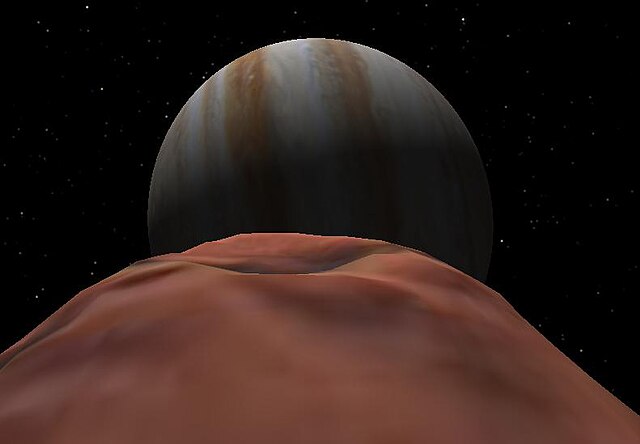Amalthea is a moon of Jupiter. It has the third closest orbit around Jupiter among known moons and was the fifth moon of Jupiter to be discovered, so it is also known as Jupiter V. It is also the fifth largest moon of Jupiter, after the four Galilean moons. Edward Emerson Barnard discovered the moon on 9 September 1892 and named it after Amalthea of Greek mythology. It was the last natural satellite to be discovered by direct visual observation; all later moons were discovered by photographic or digital imaging.
Galileo images showing Amalthea's irregular shape (1997)
Schematic of Jupiter's ring system and four inner moons. Amalthea is the third outermost moon inner, orbiting within the gossamer rings.
Simulated view of Jupiter from Amalthea.
Artist's impression of the Galileo spacecraft passing by Amalthea
There are 95 moons of Jupiter with confirmed orbits as of 5 February 2024. This number does not include a number of meter-sized moonlets thought to be shed from the inner moons, nor hundreds of possible kilometer-sized outer irregular moons that were only briefly captured by telescopes. All together, Jupiter's moons form a satellite system called the Jovian system. The most massive of the moons are the four Galilean moons: Io, Europa, Ganymede, and Callisto, which were independently discovered in 1610 by Galileo Galilei and Simon Marius and were the first objects found to orbit a body that was neither Earth nor the Sun. Much more recently, beginning in 1892, dozens of far smaller Jovian moons have been detected and have received the names of lovers or daughters of the Roman god Jupiter or his Greek equivalent Zeus. The Galilean moons are by far the largest and most massive objects to orbit Jupiter, with the remaining 91 known moons and the rings together composing just 0.003% of the total orbiting mass.

Jupiter and the Galilean moons as seen through a 25 cm (10 in) Meade LX200 telescope
Orbits of Jupiter's inner moons within its rings
The Galilean moons. From left to right, in order of increasing distance from Jupiter: Io; Europa; Ganymede; Callisto.






